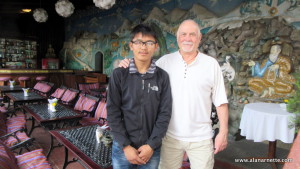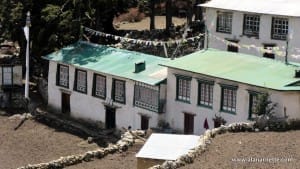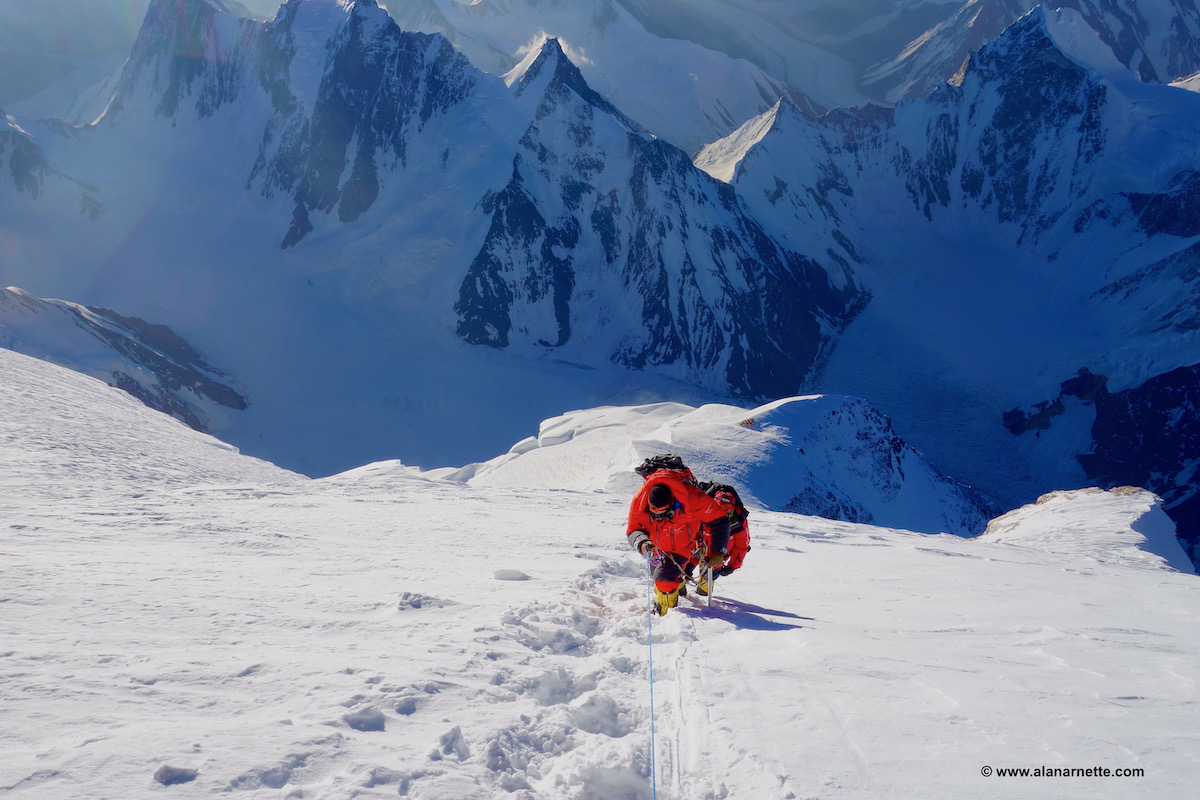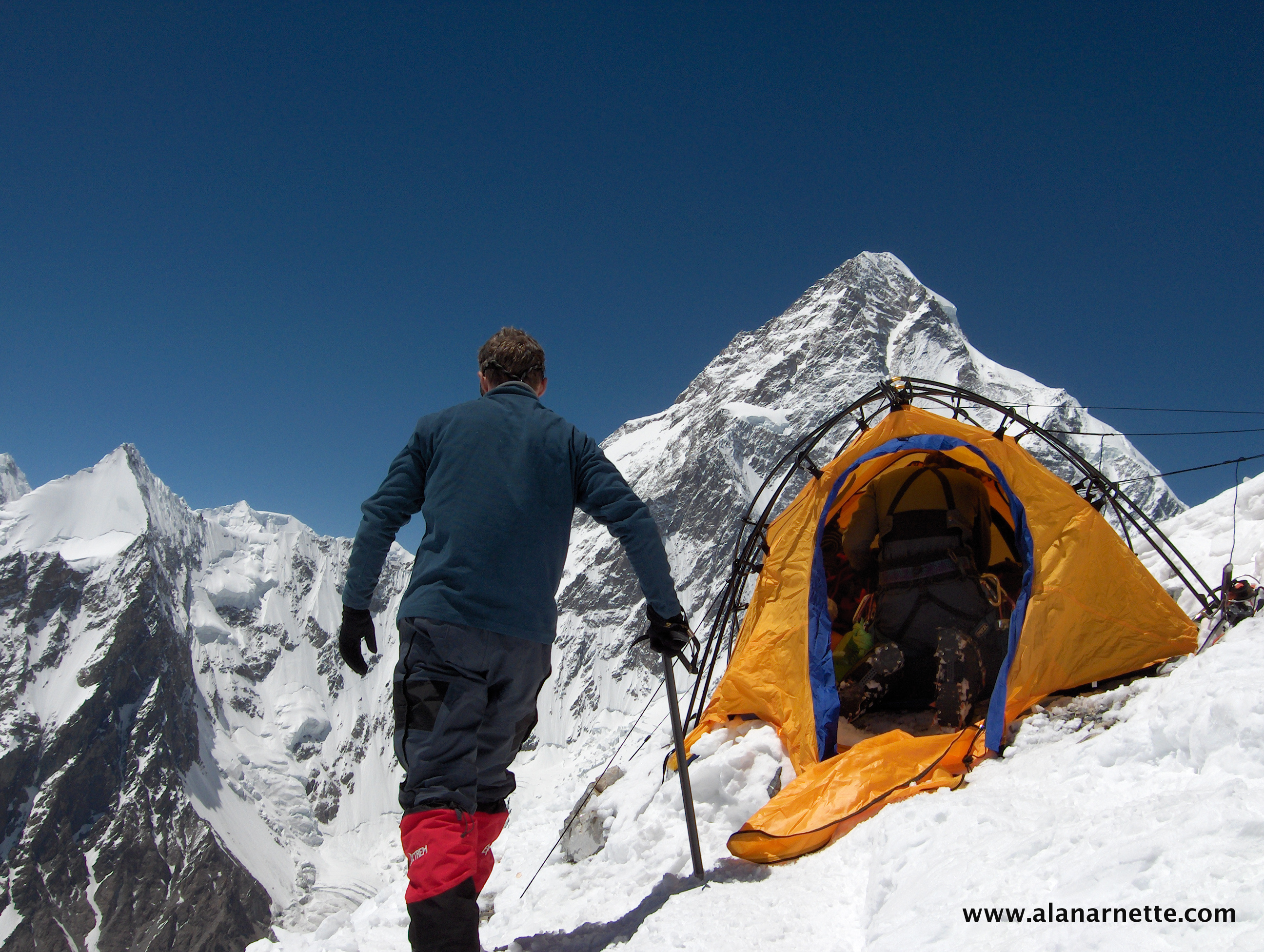Good news from Everest: the route through the Khumbu Icefall is complete through Camp 2, around 21,000’/6400. This opens the route for Sherpas to begin building C1/2 and for members to begin their acclimatization rotations shortly thereafter. Everest permits lag last year’s record of 478. As of April 15, 2024, the government issued 274 permits to foreigners compared to 338 in 2023 as of the same date; this is 20% less. While bad for business, this is good for the mountain.
Iceefall Open, But Just

Taking ten days longer than expected, the doctors did their miracle work and found a way through the jumbled ice cubes in the Khumbu Icefall, but they advised caution, as much of the route was still unstable. IMG provided a nice summary:
Apparently it is very icy this year in the Icefall (go figure) and there are several big crevasses and ice walls in the lower part of the Western Cwm which made it more difficult than normal to get to Camp 1 and then to get around more obstacles near Nuptse. Above that it is a straight shot up to Camp 2. We have IMG sherpas Sonam Tashi and Nima Sona heading up tomorrow morning to stake out our campsites at Camp 1 and Camp 2.”
Reports that the route is closer to the West Shoulder, which holds a series of hanging seracs, are a bit worrisome. These ice bulges regularly release a tiny sliver, but enough to drop tons of ice on top of the Icefall, leaving anyone there with little hope of surviving. This is why the Doctors tried to go as far toward Nuptse, the climber’s right, as possible. I’m sure there are memories of April 18, 2014, as Sherpas and Lead Guides understand the route’s position.
Speed is always suggested when climbing the Icefall, but 2024 may require climbers to be more diligent and faster than usual. Moving three feet a day, the Doctors noted five potential areas where climbers could be in danger as the glacier moves and teetering ice towers wobble. Everyone will need to be focused and get through those areas quickly. If there was ever a season for the Ministry of Tourism to allow helicopters to ferry ropes and anchors to Camp 2 for the summit route, this is the year. It’s not too late.
I’ve been asked if the late installation of the route to C2 is a problem for summits in mid to late May, and I don’t think so. The usual schedule is for teams to arrive at EBC around April 15, then take a week to rest up, adjust to the 17,5000-foot thin air and refresh climbing skills on an obstacle course next to the base camp. Then, they usually take a short trip halfway up the Icefall before making the first rotation to Camps 1 and 2. The bottom line is everything feels on track on the Nepal side.
Everest Permits
Everest permits lag last year’s record. As of April 15, the government issued 274 permits to foreigners compared to 338 in 2023, this is 20% less So whats going on? I’m building a theory that last year’s eighteen deaths, of which eleven were preventable, in my opinion, have caused inexperienced clients to have second thoughts. It appears even the lure of “low” prices in the mid-$30,000 range is not enough for many to risk their lives. We’ll see if this trend holds, but the new permit flow usually slows by mid-April. I first predicted 600 permits based on the desire to beat the permit price increase from $11,000 to $15,000 in 2025, but I was way off and will now suggest that breaking 300 might be more reasonable. This is lower than the 400 predicted by many before the season started.
Border Update

After reporting that the border between Nepal and Tibet was closed, creating havoc for some teams (Adventure Peaks switched to the Nepal side), similar to Lukas Furtenbach of Furtenbach Adventures, Adrian Ballenger of Alpenglow tells me that everything is fine and they are on track to climb in Tibet this season:
Just fyi we on track and things still matching what CTMA have been saying for quite some time. Delayed opening to last week of April. We all have our visas and are on track to arrive chengdu on 28th! Will let you know if any hiccups but for now, teams really had a long time to plan for this. No surprises yet.”
The Nepali operator Climbalaya, which is well connected with Chinese officials, says they are ready for their team to travel to the Chinese Base Camp in Tibet as soon as the border opens:
Exciting updates from the Everest Expedition North 2024 team! Our teams are acclimatizing in the stunning Langtang region, preparing for the thrill of a lifetime! As we eagerly await final permits, our seasoned local staffs are forging ahead, setting up basecamp and pushing towards middle and advanced basecamp.
April 18–A Day of Remembrance
On April 18, 2014, at 6:35 am, a small section of an ice serac released onto the Khumbu Icefall. Sixteen Sherpas were killed in the blink of an eye as tons of ice fell on top of the Icefall, leaving the mountain workers with few options and nowhere to hide. In previous years, April 18 was a day of remembrance, and no teams climbed. However, today, ten years later, in 2024, there is climbing, so the echo from that day continues to dim. And I’m sure that many Sherpas who lost friends and family remember this day with solemn unity, remembering where they were that day and who they lost.
“The tears are right below the surface.” Russell Brice, Himex, told me in 2016 while standing on the trail that defines the main street of Everest Base Camp. Brice’s words and emotions could have come from any Everest operator – foreign or Nepali. Revered Sherpa, who is now retired, Lapka Rita Sherpa told me that day:
We had great puja ceremony yesterday and our entire teams felt blessed. Today April 18th is Memorial Day of 16 sherpa’s hero’s lost theirs life during the 2014 tragic avalanche on khumbu icefall. This day is extremely difficult and super painful for me and many of my fellow climbers friends and their family.
The entire Everest base camp remain silent not involving any climbing activities to remembering those heroes, sending our thoughts and prayers. Om mani Padme hung, Om mani padme hung, Om mani padme hung. May those heroes Rest In Peace.
A four-ladder structure collapsed sometime at night in 2014 while eighty Sherpas ferrying loads into the Western Cwm approached it. As soon as the Sherpas saw the route was impassable, some immediately turned back to the safety of Base Camp, while others, too many, waited for the Icefall Doctors to repair the route.
Phil Crampton of Altitude Junkies told me in 2016:
This morning, 6 of our Sherpas, out of a total of 24 working for the Junkies this spring season, departed base camp at 3:30 AM for a load carry to camp one. Unfortunately, halfway up the icefall there was reportedly some collapsed ladders. It seems as if the route needs to be re-routed to avoid a bottleneck at this section as many Sherpas reported that no ladders had collapsed, but the trail of 80 Sherpas came to a standstill. With this in mind, Dorjee Sherpa and myself instructed our Sherpas to descend immediately and drop their loads at crampon point. The icefall is definitely not a place to stand around and wait for ladders to be fixed. The Sherpas returned to base camp with large smiles and even larger appetites.
There have been lessons from that deadly 2014 day.
Many lost long-time employees, friends, and, in many cases, family. There was no chasm between the operators or agencies about that day. They spoke quietly about great climbers, young and old, Sherpa Guides. They talked about their base camp doctors or the cameraman trying to record what makes Everest so special. Avalanches know no profession or nationality. They are random and often fatal.
Brice and others—Western and Nepali—returned the year after the avalanche and for each year since, other than 2020, when it was closed due to the pandemic. When asked why, he simply says, “It’s the right thing to do.” The cynical will discuss how much Sherpas are paid, the profit margins, and the tired old line about Sherpa exploitation by Western operators. If you ask the Sherpas, they will acknowledge the danger and income from guiding. They are pleased that about 300 foreigners are climbing Everest in 2024.

All foreign climbers are with a team that includes climbing Sherpas, cooks, and countless porters. If they say they are solo, they don’t have a partner but will never be alone on a mountain like Everest. Foreign climbers pump millions into the Nepal economy. They stay in Kathmandu hotels and eat in Kathmandu restaurants. As they trek towards base camp, they stay in teahouses and eat their meals there. Their gear is transported from Kathmandu to the Khumbu on Nepali-owned airlines. Local porters carry them further up the valley.
Yes, the $11,000 Everest permit fee goes to the government, and the Western and Nepali companies profit. However, a large part of the direct and indirect revenue that a climber pays goes right back into Nepal.
This is one reason why foreign and domestic operators return year after year despite the risks. They know what they do goes beyond helping members stand on a summit. Today’s remembrance is not a justification for climbing. It is not a marketing ploy to attract more climbers or sympathy. It is not an opportunity for another “adventure” magazine to sell advertising based on reciting decades-old myths that are no longer valid. Today is a way of honoring those who lost their lives serving others.
However, despite the devastating disasters of 2014 and 2015 and even last year’s death of three Sherpas, not much has changed for the mountain workers other than increased life insurance. After the 2014 disaster, the Sherpas created a list of demands for improved working conditions for the government, but almost none were approved. The list included:
- Increment of immediate relief announced for avalanche victims
- Provide Rs 10 million (US$103,590) each to families of the deceased
- Set up a memorial park in the name of the deceased in Kathmandu
- Cover all expenses for treatment of the injured
- Provide Rs 10 million (US$103,590) to those who cannot rejoin mountaineering activities critically
- Set up a mountaineering relief fund with 30 percent of royalty collected from issuing permits to different mountains (est $1M for 2014)
- Double the insurance amount to the mountaineering workers
- Provide additional chopper rescue to mountaineering support staff if insurance fails to cover the cost
- Provide perks and salaries, except summit bonus, through concerned agencies to Sherpas if they want to call off climbing this season
- Manage chopper to bring logistics and equipment from different camps if mountaineers decide to abandon climbing this season
- Don’t take action against SPCC icefall doctors if they refuse to fix ropes and ladders on the route this season
- Let the expedition members call off this season’s climbing if they wish so
These requests were delivered and promptly ignored by the Nepal government. Some want to place blame for the Sherpa deaths at the foot of Western Operators, even though in 2024, over 80% of all Everest climbers will be with Nepali operators. The Western operators and many Nepali have supported their staff at levels high above the non-enforced laws.
If blame is to be cited, it lies with the Nepali Ministry of Tourism, which has had multiple Ministers over the last several years. The lack of stability in the government creates a random series of rules and no enforcement on the mountain. A fractured government and a diverse ethnic population prevent further progress for the Sherpa people and those working in the mountains. The Sherpa people are viewed as already having a lucrative lifestyle and income by the rest of Nepal. These views generate jealousy and stall further advances in safety and wages by the Ministry of Tourism. However, these facts are ignored while the complexities are real. A solution is not simple.
Yes, climbers can stop climbing Everest, but what would that accomplish, and who would suffer the most?
In 2019, the last year I was in Kathmandu, I met with Kami Sherpa’s son. I summited Everest and K2 with Kami and stood side by side in the Western Cwm during the 2015 earthquake. Kami’s son, Mingma, is an impressive young man. He is 32 and graduated with an Electrical Engineering degree in Kathmandu. He’s now in Canada studying renewable resources. Mingma said he wanted to be a mountain guide like his Grandfather, father, and second oldest brother, but Kami wouldn’t let him. He said he liked the idea of adventure and did summit Everest with his father a few years ago. Interestingly, his mountain guide brother made fun of Mingma for going to school and not earning as much money as he does guiding.
His two sisters went to boarding school in Kathmandu. Karma wants to be a doctor and is in college. Dawa works in the hospitality industry in London after graduating with a degree in hospitality management. By the way, Mingma’s English is perfect. Like all his brothers and sisters, he was born in the stone house where Kami and Lhapka Diki live today. He went to grades one through five in Pangboche, then to Hillary School in Khumjung, and then to grade seven. When Kami sent him to boarding school in Kathmandu, they dropped him back to grade five because his English was poor. He went on to graduate high school and now graduated from the university.
The pressure is huge for them to stay in the Khumbu and make a few quick dollars guiding for two to four months a year, but Kami wanted a better life for his younger children—and he is seeing that come true. Mingma’s tuition was about US$2,000 yearly, and his sisters’ tuition was about $600 each.
Most Sherpas employed by Western guide companies will make between $5,000 and $10,000 guiding this spring. The low-end Nepali guide companies will pay their staff half or less for the same work. This is the quiet secret members never understand when getting a “deal” with their outfitters. Kami’s hard work benefits his children. He has the same dream as parents everywhere—for their children to have a better life than they do.
Today is a day of memories—a day when a family in Portse, Pangboche, or Thame remembers their fallen husband, son, or father. They are grateful for their sacrifice, which allowed their children to receive an education—something they never had. They are grateful that their son or daughter will not become an Everest guide. They understand the juxtaposition between risk and reward. They understand that mountains are dangerous, and they would have taken them if they had alternatives.
Their tears are real and visible today. Today is a day of memories and dreams.
Om mani Padme hung
2014 Deaths
1. Mingma Tenzing Sherpa Peak Freaks, died from HAPE
2. Mingma Nuru Sherpa, Shangrila Nepal on NBC Everest Expedition, died from an avalanche into Khumbu Icefall
3. Dorji Sherpa, Shangrila Nepal on NBC Everest Expedition, died from an avalanche into Khumbu Icefall
4. Ang Tshiri Sherpa, Shangrila Nepal, on AAI Everest Expedition, died from an avalanche into Khumbu Icefall
5. Nima Sherpa, Shangrila Nepal, on AAI Everest Expedition, died from an avalanche into Khumbu Icefall
6. Phurba Ongyal Sherpa, Adventure Consultants, died from an avalanche into Khumbu Icefall
7. Lakpa Tenjing Sherpa, Adventure Consultants, died from an avalanche into Khumbu Icefall
8. Chhiring Ongchu Sherpa, Adventure Consultants, died from an avalanche into Khumbu Icefall
9. Dorjee Khatri, Adventurist Everest, died from an avalanche into Khumbu Icefall
10. Dorjee Sherpa, Adventurist Everest, died from an avalanche into Khumbu Icefall
11. Phur Temba Sherpa, Adventurist Everest, died from an avalanche into Khumbu Icefall
12. Pasang Karma Sherpa from Juving Solukhumbu, Jagged Globe, died from an avalanche into Khumbu Icefall
13. Asman Tamang, Himalayan Ecstasy Lhotse, died from an avalanche into Khumbu Icefall
14. Ankaji Sherpa, Everest Chinese Dream Expedition, from avalanche into Khumbu Icefall
15. Ash Bahadur Gurung, Everest Chinese Dream Expedition, from avalanche into Khumbu Icefall
Missing – Unknown status, presumed dead
1. Tenzing Chottar Sherpa, Shangrila Nepal on AAI Everest Expedition, from avalanche into Khumbu Icefall
2. Pem Tenji Sherpa, Everest Chinese Dream Expedition, from avalanche into Khumbu Icefall
Alan
Memories are Everything
Everyday Everest
A new podcast series during the Everest 2024 climbing season.
Based on my 2020 Virtual Everest series, I’ll have a twenty-minute updated episode of the story a few times a week for the next two months. Everyday Everest follows a fictional team of nine climbers and their personal Sherpas from leaving home, trekking to base camp, acclimatizing, and finally, on their summit push. The story’s protagonist, Harper, sets the tone for the story when she tells her husband, Marc, “Honey, I’m going to climb Everest.”
You can listen to Everyday Everest and all of Alan’s podcasts on Spotify, Apple Podcast, Breaker, YouTube, Pocket Casts, RadioPublic, Anchor, and more. Just search for “alan arnette” on your favorite podcast platform.
Previous Everyday Everest Episodes
- Everyday Everest Podcast Series Part 7–Into the Cwm
- Everyday Everest Podcast Series Part 6–Into the Icefall
- Everyday Everest Podcast Series Part 5–Arrival At Base Camp
- Everyday Everest Podcast Series Part 4–Blessing in the Khumbu
- Everyday Everest Podcast Series Part 3–The Trek Begins
- Everyday Everest Podcast Series Part 2–Hello Kathmandu
- Everyday Everest Podcast Series–Welcome and Part 1
Previous Everest 2024 Season Coverage Posts
- Everest 2024: Tibet Climbs in Peril
- Everest 2024: Weekend Update April 14: Icefall Woes, Fewer Climbers
- Everest 2024: Will Cockrell interview on his new book–Everest, Inc.
- Everest 2024: First Days at Base Camp & 1st 8000er summit
- Everest 2024: Leaving Grass and the Trekker’s Summit
- Everest 2024: Weekend Update April 7: Climbers on the Trek
- Everest 2024: Snag in the Icefall Route
- Everest 2024: Blessings on the Trek to Tengboche Monastery
- Everest 2024: The Namche Hill
- Everest 2024: The Trek to EBC Begins
- Everest 2024: Weekend Update April 1: Season Underway, Lost Legends
- Everest 2024: Leaving Nothing Unsaid
- Everest 2024: Climbers to Watch
- Everest 2024: Who’s Climbing This Year?
- Everest 2024: Icefall Doctors Mark Season Start
- Everest 2024: Nepal’s “GPS Chip” Plan Has Major Problems
- Everest 2024 Coverage: Are Luxury Operators Being Targeted by Nepal?
- Everest 2024: Interview with Garrett Madison on his “Aconcagua Ambush” and the Upcoming Everest Season
- Everest 2024 Coverage: WAG Bags Finally Required on Everest
- Everest 2024: Welcome to Everest 2024 Coverage
Preparing for Everest is more than Training
If you dream of climbing mountains but are unsure how to start or reach your next level, from a Colorado 14er to Rainier, Everest, or even K2, we can help. Summit Coach is a consulting service that helps aspiring climbers worldwide achieve their goals through a personalized set of consulting services based on Alan Arnette’s 30 years of high-altitude mountain experience and 30 years as a business executive. Please see our prices and services on the Summit Coach website.
Everest Season Special through May 31, 2024: 10% discount on all plans. Mention Everest 2024.







